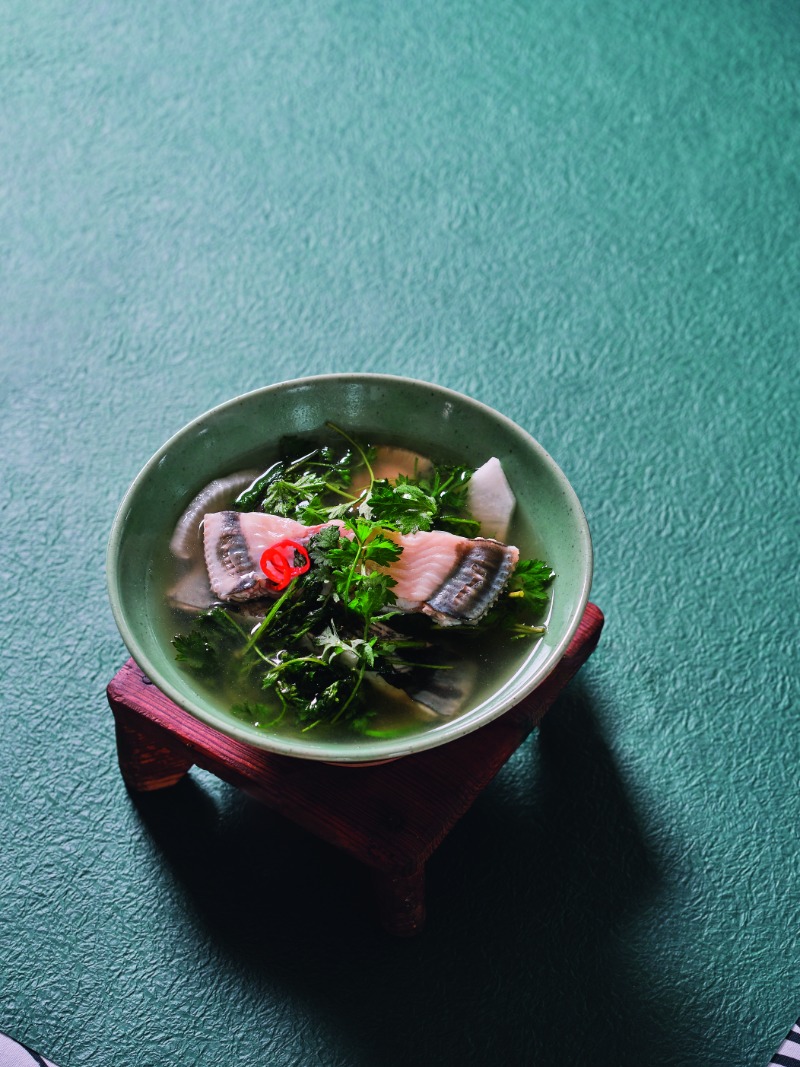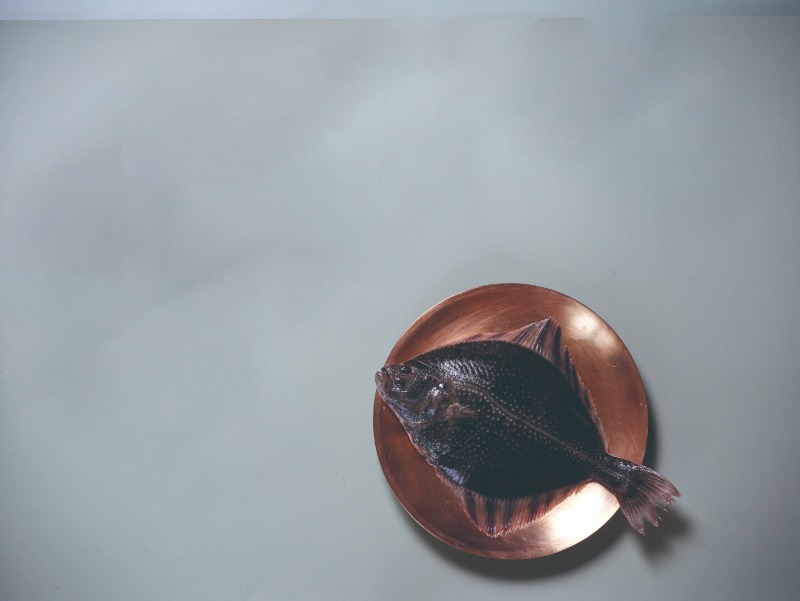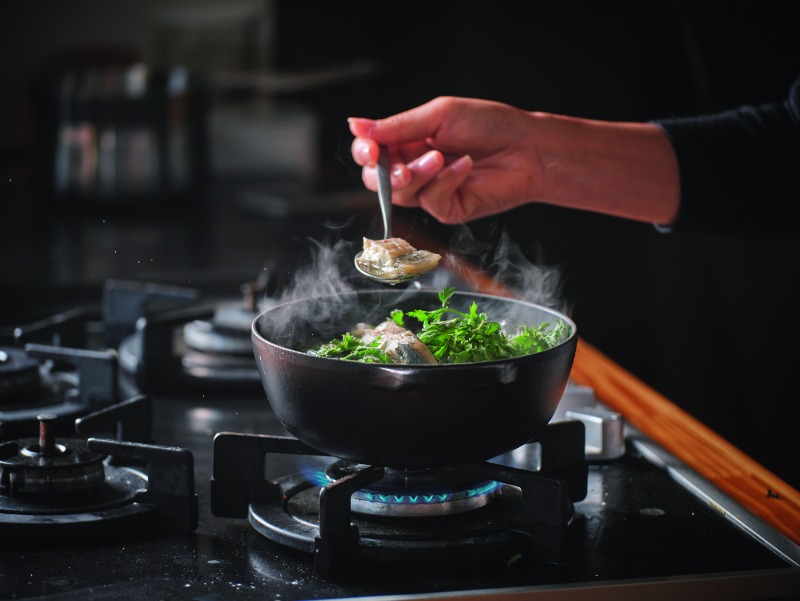As the ground thaws from the winter freeze, young shoots of mugwort are the first to emerge. Just as highly prized at this time of the year is the flounder, another harbinger of spring. When combined, the two ingredients produce a soup synonymous with spring in Korea.

Dodari ssukguk, or flounder and mugwort soup, is a specialty from the coastal city of Tongyeong in South Gyeongsang Province. At the turn of spring, coastal restaurants post signs announcing that they have begun serving the seasonal dish.
Many thingsus to the change of seasons. When the time is right, new shoots sprout from the ground and flowers bloom. Months later, the lush green of foliage changes into fiery colors, and icy wind strips branches bare. Such is the coming and going of seasons. We can also feel the change of seasons with our tongues. Is there a more intuitive way of experiencing the seasons than by savoring the freshness of seasonal foods? According to the late Korean traditional culinary expert and chef Kim Tae-won, “The fastest way to attune oneself to the change of seasons is to eat the most expensive seasonal fish.”
LOCATION AND TIMING
Since ancient times, mugwort has been used to bolster the function of the stomach, liver, and kidneys. Mugwort harvested between March and May is considered to be superior in taste.
© gettyimagesKOREA
A specialty from the coastal city of Tongyeong in South Gyeongsang Province is dodari ssukguk, or flounder and mugwort soup, highly anticipated not only for its taste but because it heralds the arrival of spring.
Flounder fatten up through the winter and migrate to the nation’s southern coastal waters to spawn when temperatures begin to rise. During the spring, they are found in abundance in Tongyeong’s waters and rushed to the city’s restaurants, where the fish is prepared in a variety of ways. One of the most sought-after dishes is dodari sekkosi — freshly cut slices of raw, bone-in flounder (dodari).
Mugwort (ssuk) has a slightly bitter taste and a fragrant smell. Young mugwort shoots harvested in early spring between March and May are superior in both texture and taste. Later, the plant takes on a rougher texture and a more bitter taste, which makes it less suitable for cooking. So, restaurants that offer dodari ssukguk scramble to get freshly picked mugwort shoots every spring, especially those grown near the seashore. The sea breeze makes coastal mugwort richer in minerals, tastier and more fragrant than mugwort from mountainous and inland regions.
In Korea, mugwort is a symbol of vitality because the plant thrives in any type of climate, soil, and environment. Consumed as food and used as medicine by Koreans since ancient times, mugwort even plays a major role in the myth regarding the foundation of Korea: a bear forced to stay inside a cave and eat nothing but mugwort and garlic for a hundred days eventually becomes human.
UNIQUE TASTE

“Dodari” is an umbrella term used for many types of flounder. Marbled flounder is found in the coastal waters of Tongyeong but fishing limits keep the local specialty, dodari ssukguk, off menus until February.
Making soup from local fish and meat with seasonal herbs and vegetables is a long-standing tradition throughout Korea. Flounder and mugwort soup is native to Korea’s southern coastal regions, though it is uncertain whether fishermen or families living along the coast were the first to combine the two main ingredients.
What differentiates dodari ssukguk from other Korean soup and stew dishes is its lack of red pepper powder. This gives it a distinctively clear broth. Since the focus is on highlighting the taste and smell of mugwort, fermented soybean paste and a light amount of soy sauce are used instead of spicy red pepper to produce a mild and savory taste. Carefully sliced flounder, well-rinsed mugwort, chopped white radish, and spring onions are then added to the soup, which is brought to a boil — and voilà, the dish is ready!
People who eat dodari ssukguk for the first time sometimes say it has a peculiar taste due to the mugwort’s slightly bitter flavor and smell. However, once they become accustomed to the flavor of the soup, they cannot get enough of it. Gourmets believe the true star of this dish is not the flounder but the mugwort. The fragrance of mugwort combined with the broth made from fermented soybean paste helps elevate the soup’s character, while the light and delicate taste and texture of the flounder enrich the flavor.
LEGACIES

The combination of flavors from the delicate taste of flounder and the fragrance of fresh mugwort puts Tongyeong dodari ssukguk on the calendar of foodies every year.
Restaurants serving seasonal dishes may start selling dodari ssukguk as early as the middle of February. Markets near fishing ports in Tongyeong are filled with small restaurants offering this quintessential seasonal dish, one of the most popular being Huijeong Sikdang. Made with freshly harvested mugwort, the soup at this restaurant has a clear broth that is among the tastiest there is. It is served with a variety of side dishes made with seasonal ingredients. The soup and side dishes go so well with rice that few can settle for a single bowl.
In central Seoul, the most famous place for flounder and mugwort soup is Chungmujib in the Euljiro area. Its history goes back to 1964, when the owner’s father first opened a restaurant in Tongyeong called Huirakjang. He put all his faith in flounder and mugwort soup and enjoyed a loyal following over the decades. One of the most popular dishes ordered alongside flounder and mugwort soup is sea squirt bibimbap. Consisting of white rice topped with thinly sliced sea squirt, white radish sprouts, laver flakes, and sesame oil, it has a savory taste that makes for a fantastic accompaniment to the soup.
All things brimming with life eventually die only to be reborn again following a long and arduous wait. The same can be said for dodari ssukguk. Spring is the time to enjoy this seasonal dish, for it will soon vanish from restaurant menus until next year.
Hwang Hae-wonEditor-in-chief, Food Service Management
Lee Min HeePhotographer